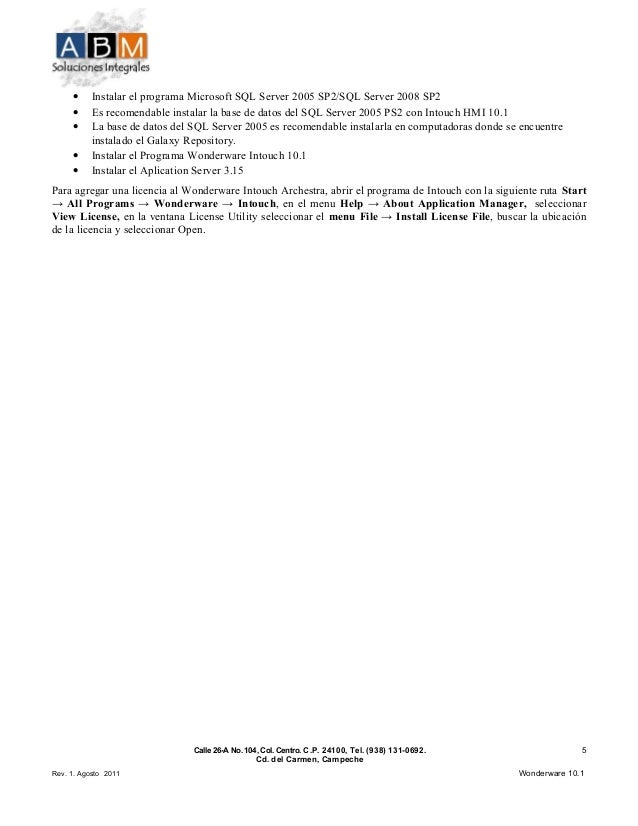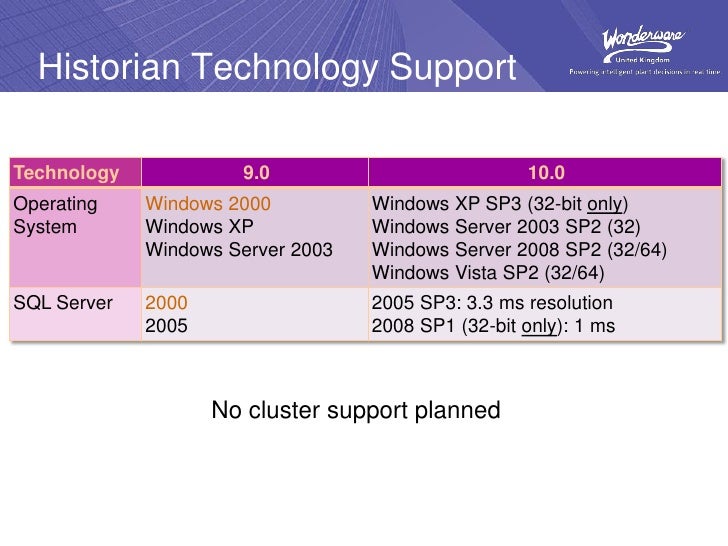Wonderware Intouch 10.1 Sp3
- InTouch 10.1 SP3 Patch 01 and Wonderware Application Server 3.1 SP3 Patch 01 Enhancement Summary. The AlarmDBLogger has been enhanced to run as a Service in Windows.
- InTouch 10.1 SP3 Patch 01 and Wonderware Application Server 3.1 SP3 Patch 01 Enhancement Summary. The AlarmDBLogger has been enhanced to.
InTouch 10.1 SP3 Patch 01 and Wonderware Application Server 3.1 SP3 Patch 01 Enhancement Summary The AlarmDBLogger has been enhanced to run as a Service in Windows Vista and later operating systems primarily to support Galaxy Alarms and InTouch Alarms from Terminal sessions. Prior to InTouch 10.1 SP3 Patch 01 and WAS 3.1 SP3 Patch01, it wasn't possible to start alarm DBLogger as a Service on Windows Vista and later Operating Systems. This limitation has been addressed in InTouch 10.1 SP3 Patch 01 / WAS 3.1 SP3 Patch 01. Note: The limitation on View as a service still exists. You can now configure Alarm DB Logger manager to run as a service in any of the supported operating systems. This is made possible in order to support environments where it is not feasible/typical for an operator to be logged in to the 'console' session.

With this change, Galaxy Alarms as well as InTouch alarms from Terminal (RDP) Sessions can be logged into the alarm database. The following limitations still apply. The combination of Alarm DB Logger configured as a service and InTouch running locally as a console application is not supported. If InTouch needs to run in the Console session, the AlarmDB Logger must be run as a Normal Application. If Alarm DB Logger is configured to run as a service and is configured to log Galaxy Alarms, it cannot simultaneously log alarms from an InTouch application running in the console. It can however, log alarms for any InTouch application running as a session. Supported Queries When AlarmDbLogger is Configured as a Service For InTouch alarms from Terminal Sessions: InTouch!$System Where:.
Disable UAC before installing the Wonderware Application Server 3.1 SP3 and InTouch 10.1 SP3, applicable for Windows Vista and above operating systems. If your version of Wonderware Application Server is 3.1 SP2 or earlier, then upgrade it to Application Server 3.1 SP3, before upgrading to InTouch 10.1 SP2 to 10.1 SP3.
Dragon ball super. The 59-year-old famous manga artist confirmed in Weekly Shonen Jump, that the forthcoming film will have a brand new story that will be set after the events of the previous movie (which is also credited to him) 'Dragon Ball Z: Battle of Gods.' He further revealed that the plot is intended as if it were a continuation of the 1984 Dragon Ball manga serialization.
TerminalServerNodeName is the computer name of the Terminal Server Node. TerminalSessionIPAddress is the IPAddress of the TS Client initiating the session. This is the session IP of the alarm provider. This is not the IP address of the terminal server. For example. Terminal Server Computer name: TSNode1.
Terminal Server IP Address: 10.2.1.1 (As returned by an command executed from the console). Terminal Session IP Address: 10.2.1.67 (This is the IP addresss of the terminal client as returned by an command executed from the terminal session. You can also rely on the InTouch function TSEGetClientId executed from the InTouch Application in a Terminal Session. For Galaxy alarms. For alarms from local platform: Galaxy!. For alarms from remote platforms: Galaxy!

Application Versions. InTouch 10.1 SP3 Patch 01 and later. Wonderware Application Server 3.1 SP3 Patch 01 and later. Microsoft Vista and later Operating Systems. Microsoft Server 2008 and later Operating Systems.
Introduction for Original InTouch 10.1 SP3 Release Note: The following information is presented to preserve legacy functionality prior to InTouch 10.1 SP3 Patch 01 and Wonderware Application Server 3.1 SP3 Patch 01. The InTouch HMI and AlarmDBLogger cannot be configured to run as services in Windows Vista or later operating systems. This includes Windows Server 2008, Windows Server 2008 R2, and Windows 7 operating systems. In these operating systems, services are no longer allowed to interact with the desktop. Services now run in Session 0, and interactive processes (such as the InTouch HMI and AlarmDBLogger) run in a Session ID greater than 0. This Tech Note describes an alternative which allows the user to autologon on startup, auto-start View and Alarm related processes and then lock the desktop. The locking of the Desktop is an optional security step in case the user being auto-logged on is not present when the computer is rebooted.
Please note that if this user is logged off, all processes auto-started by this user will stop. Also, if another user logs on concurrently, you can start duplicate instances of the same processes. So, the ideal scenario for these suggestions to function is to keep the logged on user the same as the one specified for AutoLogOn. Complete these steps to set up the batch file. The entire content is reproduced below for copy/paste purposes. Configure the AutoLogin of a well-known user in the Windows registry. For this example, it is DomainX UserX.
Wonderware Intouch 10.1 Free Download
Put the.bat file on the node at which you want to Autostart Wonderware applications. For example C: bat WonderwareAutoStart.bat.
Wonderware Intouch 10.1
Copy the.bat file and paste it as a shortcut in C: Users UserX AppData Roaming Microsoft Windows Start Menu Programs Startup.